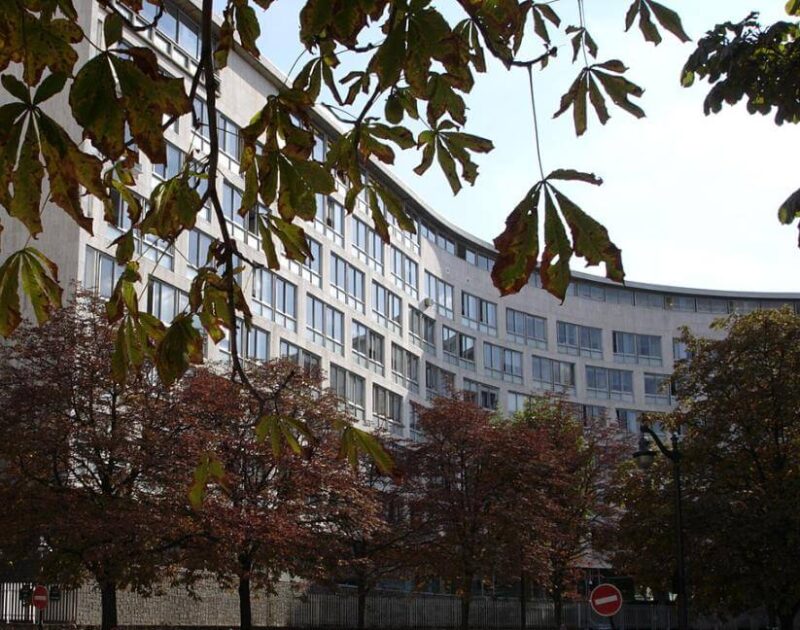One of the most recognizable buildings in Paris—especially from above—is the UNESCO Headquarters building, also called Maison de l’UNESCO. Seen from overhead, this building features a Y-shape with three wings sweeping outward like spokes on a wheel.
This intriguing structure has a tumultuous history. But thanks to the combined efforts of a talented team of architects and artists, it stands today as one of Paris’ most famous Mid Century Modern structures.
A Project Plagued by Turbulence from the Start

Planning for the UNESCO Headquarters building in Paris began in 1951. Brazilian delegate Paolo Carneiro originally recommended Le Corbusier to oversee the project as its chief architect.
Alas, Le Corbusier had come to blows with Wallace Harrison a few years earlier regarding a different project in New York for the United Nations Headquarters. To top it off, Le Corbusier was expensive. So, U.S. State Department representative Jacobs shot down Carneiro’s suggestion.
UNESCO then put together a team with the following composition:
- Provisional architect: Eugene Beaudouin
- Consultants: Howard Robertson, Eero Saarinen
- Head of International Panel of Advisors: Walter Gropius
- Panel of Advisors members: Ernesto Nathan Rogers, Lucio Costa, Sven Markelius, Eero Saarinen, Le Corbusier
While heading the Panel of Advisors, Gropius continued to advocate for Le Corbusier. The Committee ultimately disregarded him, choosing the following team:
- Architect-Engineer Team: Bernard Zehrfuss, Marcel Breuer, Pier Luigi Nervi
The Panel of Advisors also stayed on to help with the project. Le Corbusier hoped that he’d be able to exert considerable influence over the design, but his ideas were largely disregarded. He eventually grew bitter about the project and its final results.
While she did not receive as much attention for her role on the project, Beverly Lorraine Greene, who was working alongside Marcel Breuer at the time, also contributed to the design of the UNESCO building.
Defining Features of the UNESCO Headquarters Building

The completed UNESCO building is called the “three-pointed star,” in reference to its Y-shape. Seventy-two columns of concrete piling support the structure. The curved shapes of the facades bring a graceful aspect to counterbalance the building’s otherwise heavy appearance. The north and south entrances feature concrete canopies with an almost sculptural look.
A distinctive feature of the building are the sunshade mechanisms over the windows. While these mechanisms might appear practical and innovative, alas, they failed to actually keep the interior of the UNESCO building cool.
UNESCO’s Headquarters building also features commissioned works of art by Pablo Picasso, Joan Miró, Henry Moore, Jean Aarp, Isamu Noguchi and Alexander Calder.
The UNESCO Meditation Space

The UNESCO building was completed in 1958, but the UNESCO Meditation Space added in 1995 is worth a look. Designed by Tadao Ando in commemoration of UNESCO’s 50th anniversary, it takes the form of a concrete cylinder. Entering the cylinder, one may sit and contemplate.
The granite slabs used in the construction of this meditation space were reclaimed from Hiroshima. While they are safe today, they were initially irradiated by the atomic bomb. This knowledge together with the austere design have a grounding, sobering effect. Those who visit this place are thus reminded of the life-and-death stakes of the cooperative international work that unfolds at UNESCO.
If you liked reading about the UNESCO Headquarters building in Paris, you may also enjoy The Simple Geometric Beauty of Breuer’s BCC Buildings.And of course, don’t forget to follow us on Instagram, Facebook, Pinterest and YouTube for more Atomic Ranch articles, house tours, and ideas!












